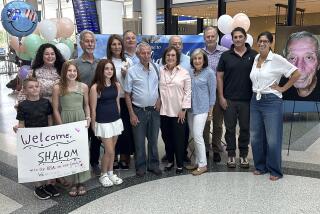While She Was Busy Fretting, They Were Busy Bonding
- Share via
The dictionary calls them “collateral relatives--more distant than a brother or sister, descended from a common ancestor.”
We know them as “cousins,” and I grew up with more than a dozen. We all lived within a few miles of one another, our lives inextricably intertwined.
As kids, we spent every holiday together, and via family caravan each summer we journeyed from Ohio to Alabama, where we’d spend weeks on our grandparents’ farm, cheek by jowl in the old farmhouse that once had been our parents’ home.
Hardly a week passed that we didn’t see one another, my cousins and I. We moved through childhood and adolescence together, our lives taking shape in the shadows and light we cast as we grew.
Then, there were the other cousins, the two children of my aunt and uncle in California . . . the “collateral relatives” we hardly knew.
We saw them three, maybe four times during all our years of growing up, when funerals or family reunions drew them near. They existed on the periphery of our lives. We may have shared the ancestry, but they could claim none of the history.
Now grown, I have landed in that uncomfortable role--the California sister, living 3,000 miles from her family.
And my children are the odd cousins out--growing up without bonds to their collateral flesh and blood.
Their cousins back East share connections with one another that my daughters will never know--ties of shared experience, the daily comings and goings that mark them as kin.
We visit every year or so, but it’s barely enough to give my girls more than a glimpse of the kind of life with cousins that I recall. Just when they’re getting the nicknames straight--learning which cousin is liable to get you in trouble, which one tells stories you shouldn’t repeat--it’s time to head for home again.
*
It is not exactly like having family across town, but after 20 years of isolation as my family’s sole West Coast wing, my brother’s move to Northern California this summer felt like a chance to re-create the family of my youth.
With his wife and baby son, he would enlarge our small circle and make possible holiday celebrations that included at least one cousin--and did not involve cross-country flight or a time zone change.
His family came down for Halloween, and we made plans to spend Thanksgiving at their new home. I could picture the gleam in my children’s eyes as I rolled out our new family scheme.
Instead, I saw tears rolling down my daughter’s cheeks.
It’s not that she doesn’t want to see her cousin, she explained, “but I’m used to spending Thanksgiving with Amanda’s family . . . like we always do.”
I stopped short, caught off guard by the power of tradition to shape my daughter’s dreams. Amanda is her sister’s friend, whose mother invited us to their family dinner four years ago so we wouldn’t have to spend Thanksgiving alone the first year after my husband died. Since then, we’ve spent almost every Thanksgiving and Easter with them, sharing turkey and football and Easter egg hunts with a family of aunts, uncles and cousins not our own.
And I realized that while I’ve been fretting over my children’s lack of family ties, they’ve been constructing bonds of their own, cobbling together traditions with neighbors and friends.
So Sara, our old au pair, still shows up on their birthdays each year, like the cousins I wish they knew. And our neighbors, the Allens, dote on them with cookies and crafts, like their grandparents would if they were here.
And if sometimes this life out here without extended family feels lonely to me . . . well, it is all my children have ever known. And when their friends speak of family fetes with aunts and uncles and cousins galore, it tugs not at my children’s hearts, but mine.
*
Sandy Banks’ column will appear on Sundays and Tuesdays. Her e-mail address is sandy.banks@latimes.com.
More to Read
Sign up for Essential California
The most important California stories and recommendations in your inbox every morning.
You may occasionally receive promotional content from the Los Angeles Times.













